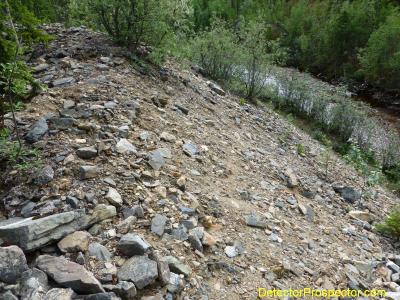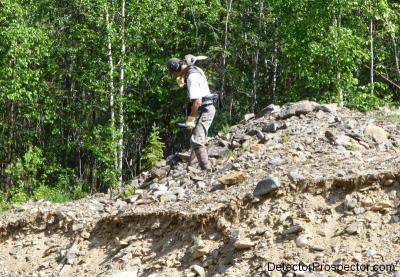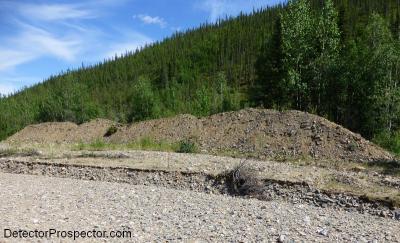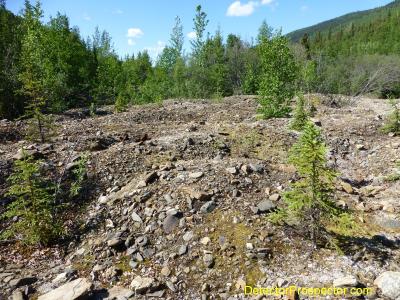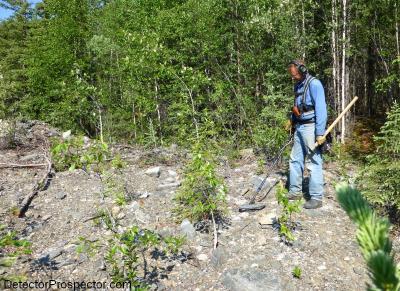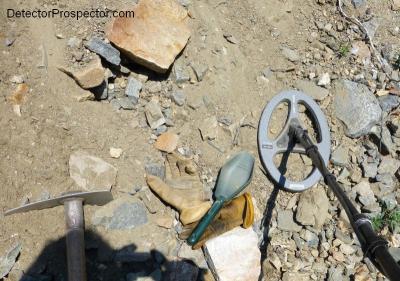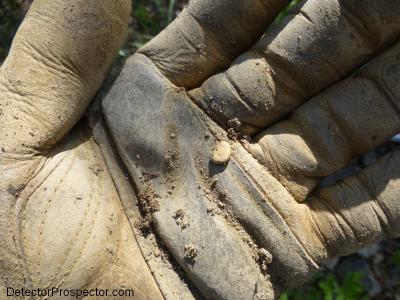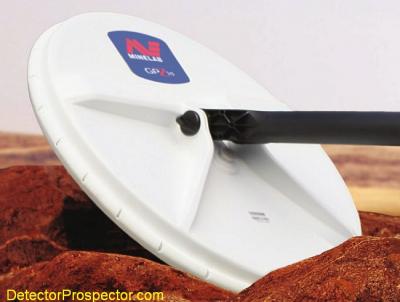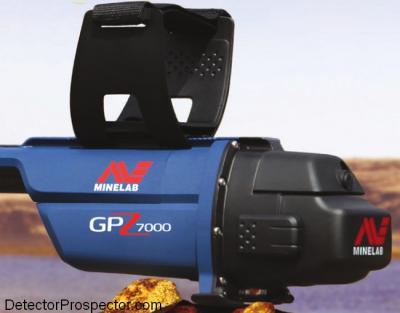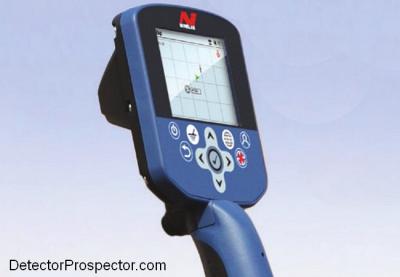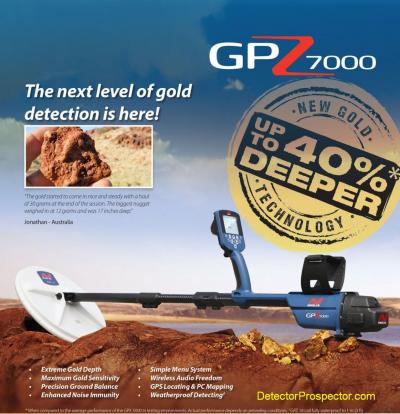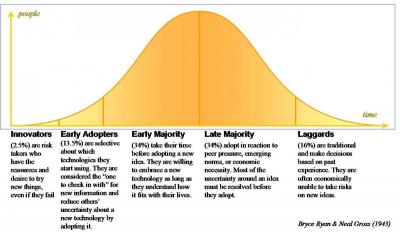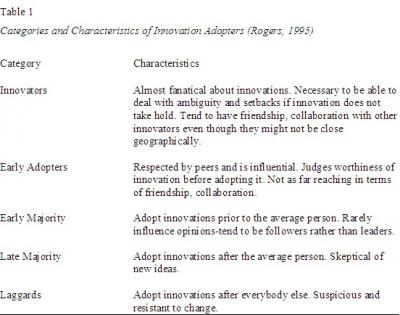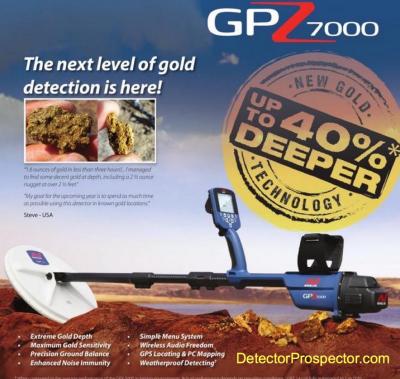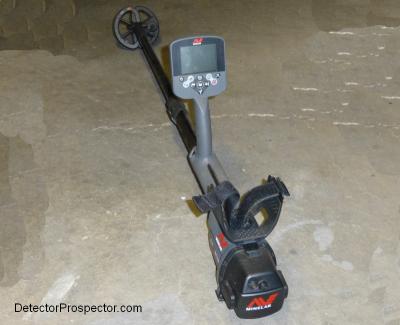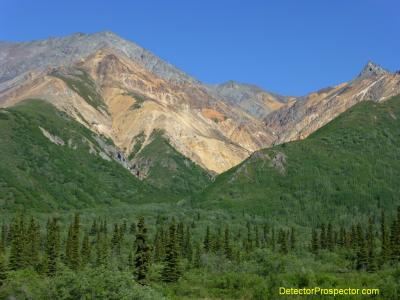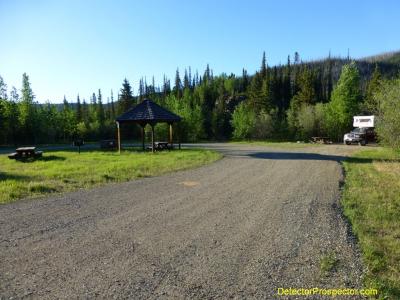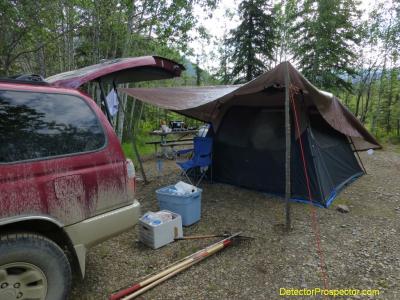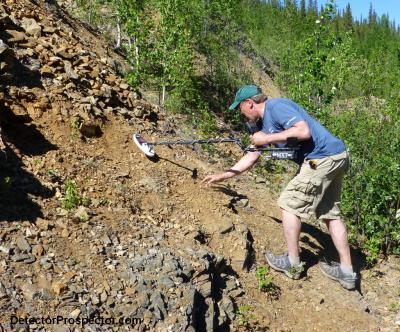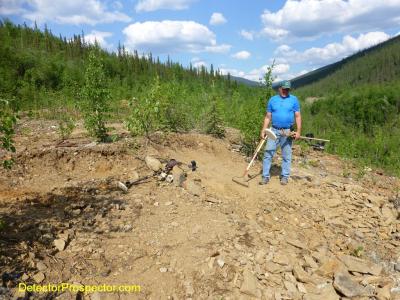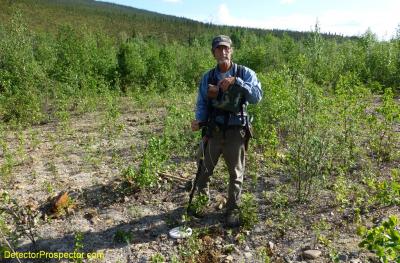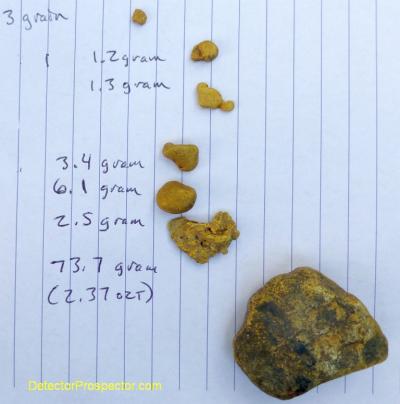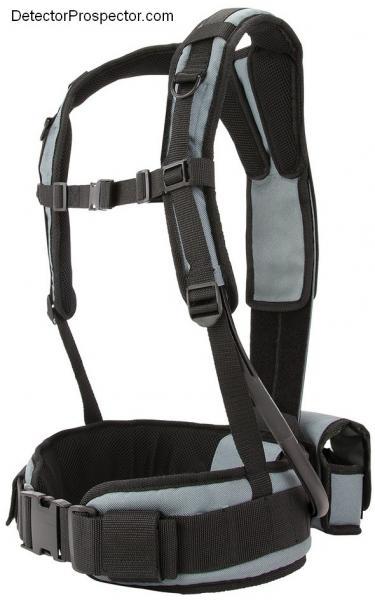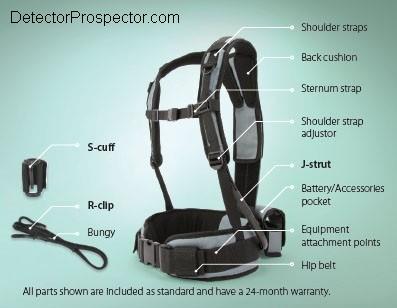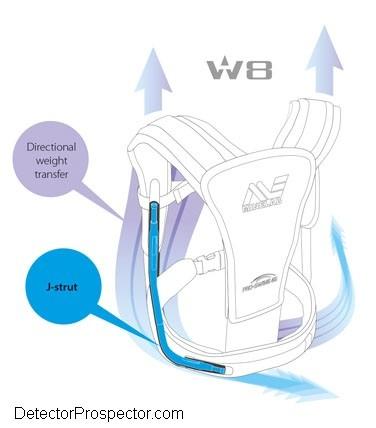-
Posts
19,679 -
Joined
-
Days Won
1,563
Content Type
Forums
Detector Prospector Home
Detector Database
Downloads
Everything posted by Steve Herschbach
-

More Depth From A Gold Bug 2
Steve Herschbach replied to nugget65's topic in First Texas - Bounty Hunter, Fisher & Teknetics
The Gold Bug 2 is interesting in that it probably shows more difference between an air test and an in ground test than any other prospecting detector. The super high frequency is hot on tiny gold but also reacts strongly to ground mineralization. That means small coils work best, because large coils see too much ground. The large Gold Bug 2 coil will of course cover more ground, but in anything other than mild ground can actually give you less depth, not more. However, in very mild ground it can perform well. The 6" coil almost never leaves my Gold Bug 2. I think of the 10" coil as the big coil. The 14" I generally do not recommend unless you have mild ground. I did use a 14" coil to find a 5 ounce nugget at good depth at Ganes Creek, Alaska. In milder ground the 14" coil will punch deeper on large gold, as show by this chart. -
All Minelab coils and detectors come with scuff covers. Most brands do not. I know there are people that buy a Minelab who are used to other models who just go ahead and get a scuff cover also. I remember a guy telling me once his scuff cover would not go on the coil, and I had to point out to him it already had a scuff cover on it!
-

GPZ 7000 40% More Depth - Really?
Steve Herschbach replied to goldbrick's topic in Minelab Metal Detectors
Good catch Skip, I did not see that, but the GPZ housing does look longer in the photos at least. Rick, all we can do is keep on the manufacturers about ergonomics. The problem is so few people that work at detector companies actually go detecting. If you just heft any of the heavy machines they feel just fine. It is after 6 hours it is a different story, and throw rough terrain in there and it just gets worse. We now have so many choices in VLF detectors that there is no reason to swing a heavy VLF. Unfortunately ground balancing PI is another story, with limited options. The prize for best GBPI ergonomics so far goes to the 3.5 lb TDI SL but unfortunately the horsepower is lacking. Having used the TDI SL I can only dream of what the SDC 2300 would be like in a similar housing. -

Steve's 2013 Alaska Gold Adventure
Steve Herschbach replied to Steve Herschbach's topic in Detector Prospector Forum
The weather in the Fortymile area the summer of 2013 was really hot in June and July. Hot for Alaska anyway running in the 80's and into the 90's, and with the humidity it just gets a bit sweltering out there in the tailing piles. A lot of the stuff I was working was steep and bare sided. Lots of side-hilling with sweat dripping off me. Jack Wade was dredged with a bucket line on the lower portion, but it was remined later with bulldozers. The upper valley was mined with bulldozers and draglines. There are just all sorts of different tailing piles up and down the creek. In narrow portions of the valley tailings are stacked and pushed high up against the valley wall. Here is a shot looking down from on top of one, with the creek below. The creek is running very low due to hot, dry weather. Working the piles can be a lot of work, with the steep sides and loose rubble. Here is Bernie working a pile with a Minelab X-Terra 705. The ground is not all that mineralized really and there is a lot of trash, so a good VLF can actually be pretty effective on Jack Wade. The piles in the wider portions of the valley are piled up but can also be pushed into huge relatively flat areas. Here is one long pile I worked pretty hard a couple times. I got a number of nice half to couple gram pieces out of it. These piles are large and it can take a couple days just to work something like this halfway well. Since I was in this for the long run my days varied a lot. There is pretty much more daylight than a person can stand, so some days I might work in the morning, take a break for lunch, work the afternoon, break for a quick meal, then work a few more hours in the evening. Other days it was just so hot I might take a break mid-day and pick up again later when it cooled down. Or just quit early. Afternoon thunderstorms were common. This second week was lots of hours and not a lot of gold showing up. I try to average a couple grams a days and I was just barely doing that. Here is my journal entry from June 27, a particularly hot, muggy day: "Hunted Bernie's Pile for four hours with Minelab, dug tons of targets, sweat pouring. Muggy and a fire someplace making smoke in the air. Shot the BS with Bernie at lunch, it rained a bit. Then hunted two hours on Steve's Hill with 18" mono. Got a few deep nails and a can so felt good about that, but no gold. Lots of interference in the afternoon, no gold. Quit early and took a dip on the creek. Brrrr!! ice cold but felt good! Ray from California came over when I got back to camp, had me sign a copy of ICMJ article I did for his buddy Ron" We end up naming various tailing piles, often after the first person to find gold on them, or some location based name. It helps as you talk about stuff "oh, yeah, I was hunting Dead Caribou pile and found a nugget" is a typical comment. Steve's Pile was one I had found gold on with a smaller Minelab coil and rehunted with the larger coil. My comment about feeling good about finding nails and a can is not sarcasm. I was happy it was coming up with targets missed previously. Any one could have been a nugget. You do not like digging junk, this is not the game to be in. Ray was a guy up from California I met in the campground. He was there by himself, then met up with some buddies who drove up, and then alone again after they left. Nice guy, hard working, mostly shovel work though. He was getting decent but not great gold considering how hard he was working, but I think he was having a good time just being in Alaska. Here is an example of a more typical flatter type tailing area seen in wider portions of the creek. Here I am below in my typical get up, though this summer saw a lot of days with me in a t-shirt. Note the lack of head net. The hot dry conditions meant minimal bugs, a real treat in Alaska. I am packing a little snub nosed .44 here but ditched it for most of the trip when it became apparent bears were few and far between in the area. There was a lot of caribou kill around from hunters the previous fall and I would get nervous stumbling on the carcass but everything was long since picked over. Never did see a bear there all summer though they were there. Some scat here and a track there made that evident. I was running a Minelab GPX 5000 with a Nugget Finder 14" x 7" mono that JP gave me when I was in Australia. Just loved that little coil, great for working in the bushes and rubble. Then I would use another JP gift, the Nugget Finder 18" mono now and then if I thought an area worth the effort of digging deep junk. The pick is a Walco pick that I put a hickory sledge hammer handle on, very handy as a walking stick on those steep hillsides. Here are a couple typical nugget finds from week 2. The little round slug is a classic Jack Wade nugget, gold from ancient high river deposits already well rounded before Jack Wade cut the old channels and rolled them around some more. Who knows where the source is, probably long since eroded away. The whole time I was prospecting my house was for sale in Anchorage. I had my satellite phone and would call my wife every day in case the realtor had called her. We had one deal early on that fell through, and now I found out a second deal had come apart. The market in Anchorage was hot and our realtor was certain no problem selling the place but it was still kind of hanging over me the whole time. The second week wrapped up with only smaller nuggets found, but total was now up to 3.37 ounces in two weeks. I was still basking in the glow of the big nugget found the previous week and really just enjoying myself at this point. Here is a different bit of Alaska gold to finish up the second installment of this tale. -

GPZ 7000 40% More Depth - Really?
Steve Herschbach replied to goldbrick's topic in Minelab Metal Detectors
Hi JP, Well, it all depends on weight. I have a CTX 3030 and at the time I posted that in 2012 I saw lots of people trying to make a GPX 5000 into a "normal" detector. You see detectors with external batteries and speakers strapped on; pretty common actually. The problem of course is that at 5.3 lbs to start with on the GPX by the time you add the battery, speaker and such it all adds up. The CTX 3030 weighs 5.2 lbs and my vision was a GPX 5000 stuffed into a CTX housing and weighing just that. I think we can agree that would be pretty sweet. Already though looking at GPZ photos I am seeing a larger battery and larger coil so that's obviously not going to happen. I have given Garrett a ton of grief over the ATX weighing too much and don't see why I would be any easier on Minelab if the GPZ is overly heavy. There is no reason at all that I can see why detectors designed from the ground up for prospectors can't weigh less. However, nobody seems to be doing that designing. The excuse used to be prospecting is a niche market, but can that really be true any more? -
This ad image is being circulated widely on the internet. Through the magic of zoom, cut, and paste, here are some close up shots. More information on the Minelab GPZ 7000 here as available. Close Up of Minelab GPZ 7000 Armrest and Battery Close Up of Minelab GPZ 7000 LCD Display and Controls Close Up of Minelab GPZ 7000 GPZ 14 Waterproof Coil
-

GPZ 7000 40% More Depth - Really?
Steve Herschbach replied to goldbrick's topic in Minelab Metal Detectors
The new Tide will make my already whiter whites whiter. You can make statistics say whatever you want. It will be fun to watch. It is all very predictable. Every PI that Minelab has ever released is met with extreme skepticism and complaints about the price. Rewind the clock to when the GPX 5000 was released. You can Google up tons of posts about how it really is no different than a GPX 4500 and not worth the extra money. Now if you wander around the forums it is now just a commonly accepted fact that the GPX 5000 represents the state of the art. It has been the same pattern with every model going back to the SD2100. I admit I used to hold off but quite some time ago I learned that when a new Minelab came out I should just get it ASAP. I actually thought this machine was going to come out two years ago because Minelab introduces new machines every two - three years, so I sold my GPX 5000 in the fall of 2012. I figured the new model would come out that winter. Shows what I know, I had to buy another GPX 5000 in the spring of 2013! Anyway, as soon as I got wind of this one I sold my GPX 5000 - again. My expectation is it will cost a lot and people will be skeptical and hold off. My plan is to have a GPZ 7000 in my hands for as many hours as I can this year. In fact my goal is to set a new personal record for hours spent detecting in a year in 2015. My recommendation is that everyone just wait and not worry about it and I will get back to you about the 40% thing this fall. Or maybe next spring! I honestly am not going to worry about it myself as it is what I am committed to using and it is going to find what it is going to find. No doubt like every detector I have ever used something else may have found whatever it is also. I could just have kept swinging my GPX 5000 this summer and been just fine. The holes I am digging are deep enough, thank you very much! But I have never yet regretted upgrading to a newer model Minelab. Not once. I am betting I do not regret this upgrade either. -
Well, I guess I got my wish. Here is a copy of my post from October 17, 2012 at http://forums.nuggethunting.com/index.php?/topic/9655-minelab-ctx-5000/ "I have a Minelab GPX 5000 and a Minelab CTX 3030. I am a firm believer at this point that the GPX 5000 has taken PI nugget detecting technology about as far as it can go, with only better ferrous discrimination the only thing to offer me. And I am not holding my breath for that. So where to go from here? Pretty obvious I would say. Cram the GPX 5000 into the CTX 3030 package. I see no reason why it can't be done. The only limitation would likely be battery time per charge but if a CTX style battery could get me just a half day operation I am fine with changing batteries at lunch. A GPX 5000 is a single package with built-in speaker and GPS and waterproof to 10 feet would be killer. A new coil set mimicing the CTX set would be great as new waterproof coils would be a must. 8" mono, 11" (or 12") mono and 11" (or 12") DD and 18" mono would be all I would ever need. People are already using the GPX for beach and relic hunting and this would put it over the top. I would be using it for almost any detecting at all except where discrimination is a must, like turf hunting in a park."
-

Makro Racer - Change In The Pro Package
Steve Herschbach replied to Nokta Detectors's topic in Nokta / Makro Metal Detectors
Hi Merton, An original complaint I had with the FORS Gold was that the scuff covers were paper thin. I mentioned it, and through the magic of listening to customers they were almost immediately reformulated to be thicker and tougher. I will vouch for the new scuff covers - I doubt many people will have issues with them. These are the new covers I was sent. -

Minelab CTX 3030 for Gold Nuggets
Steve Herschbach replied to Steve Herschbach's topic in Minelab Metal Detectors
So JP, any more news about your CTX 3030? I have been staying near home this last month, writing and selling used detectors. I am heading to New Orleans in a week for the Minelab Conference. I have not had any time yet to get my CTX out in the field looking for gold. My real prospecting will start in March. Some Details on Find Made in Video CTX 3030 Finds Gold Near Palmer River, Australia -

Steve's 2013 Alaska Gold Adventure
Steve Herschbach replied to Steve Herschbach's topic in Detector Prospector Forum
I have too many detectors Tom, so I can't afford new trucks! I bought that 1998 used with 50,000 miles on it around 2005 and drove it up until I moved to Reno. I replaced it with another used 4-Runner. -
I thought Minelab did not advertise in the ICMJ? Dealer ad? But then dealer would have to have advance info. Interesting. The original Arizona post is on Bills forum at http://www.nuggetshooter.ipbhost.com/index.php?&showtopic=28257 Wonder if Scott minds if we post copies of ads? Hope my issue shows up soon!
-
I spent a couple months in Alaska prospecting for gold in the summer of 2014. That adventure was chronicled as it happened here on the forum at Steve's 2014 Alaska Gold Adventure. It was a great trip and a great adventure, but when I told it I relayed the fact that it was actually part two of the story. Part one happened in 2013 and for reasons you will now discover I kept quiet about it until now. Those interested in the logistics of making the trip to Alaska and details on where I stayed, etc. will find all that covered in the 2014 story so I will not repeat that stuff here. 2013 was a momentous year for me. My business partner and I had sold the business we started together in 1976 to our employees in 2010. My partner immediately retired but I stayed on a few years to oversee the transition. Things seemed to be going well enough that I announced my retirement to take place in the spring of 2013. My wife and I had purchased a new home in Reno, Nevada and so plans were made to sell our home in Alaska and move south. At the same time, some partners and I had acquired some mining claims on Jack Wade Creek in the Fortymile country near Chicken. Alaska. My plan was to move my wife south then spend the summer gold dredging with my brother. The disaster struck. I screwed up the paperwork and the claims were lost. That mess was described online at Making Lemonade Out of Lemons and I even wrote an article for the ICMJ about it. I was not to be deterred however and made plans instead to go metal detecting for the summer. Unfortunately, my brother also had a change of plans and so was unable to make the trip with me. Just as well as I ended up having my hands full. The house sale was in progress and time running out so I boxed and palleted everything we wanted to keep and shipped it south. Then I loaded my wife and dogs up in the car and drove them to Reno. Next I flew back to Alaska and had a last big garage sale. I sold everything I could by the afternoon and out a FREE sign on what was left. Worked great - the house was empty, I cleaned it up, and pretty much left it to the realtors at that point. Finally, on June 16th I jumped in my fully loaded truck and headed for the Fortymile! On the way up just past the town of Palmer on the way to the town of Glenallen you pass Sheep Mountain in the Talkeetna Mountains. It is a very colorful, mineralized peak and it was a beautiful sunny day so I stopped and took this photo. Sheep Mountain, Alaska From the USGS ARDF file at http://mrdata.usgs.gov/ardf/show-ardf.php?ardf_num=AN080 Early Jurassic greenstone and minor interbedded sandstone and shale is intruded by numerous mafic dikes and at least one body of unmineralized Jurassic granite. Greenstone has been hydrothermally altered and contains at least 6 separate gypsiferous deposits in altered zones along joints and shear zones. Deposits composed of pods and stringers of gypsum, quartz, alunite, kaolin minerals, pyrite and serpentine minerals (Eckhart, 1953). The gypsum-bearing material averages 25 to 30 percent gypsum, with a maximum of 50 percent. In addition also reported from same general area are: (1) small irregular quartz-calcite-epidote veins in greenstone containing chalcopyrite, malachite, azurite and possibly bornite and chalcocite (Berg and Cobb, 1967); (2) disseminated chalcopyrite in greenstone over 5 ft thick zone subparallel to bedding (Martin and Mertie, 1914); (3) trace gold in samples of pyritic greenstone (Berg and Cobb, 1967); and (4) minor anomalous concentrations of copper and gold associated with some of the alteration zones and nearby veins (MacKevett and Holloway, 1977). Large area of south flank of Sheep Mountain is stained dark red from oxidation of pyrite in greenstone (Berg and Cobb, 1967). Oxidation of Cu minerals. The gypsiferous material averages 25 to 30 percent gypsum, with a maximum of 50 percent. The six deposits indicated and inferred reserves contain about 659,000 short tons of gypsum material, of which about 50 tons of this material had been mined (Eckhart, 1953). In addition, about 55 tons of clay was mined for the manufacture of fire brick and boiler lining. Samples of pyritic greenstone assayed trace gold (Berg and Cobb, 1967), and nearby veins in alteration zones show concentrations of copper and gold (MacKevett and Holloway, 1977). We did a talk radio show for many, many years at our company. The latest of several "radio personalities" to work with us on the show was Kurt Haider. He had expressed an interest in metal detecting so I invited him up to look for gold. I met him along the way just before we got to Glenallen and headed on to Tok for a bite to eat at Fast Eddie's. Then on to Chicken and finally Walker Fork Campground by evening. This is a very nice, well maintained BLM campground at the mouth of Jack Wade Creek where it dumps into the Walker Fork of the Fortymile River. The campground hosts this summer were a very nice couple named Pat and Sandy. Walker Fork Campground Steve's Camp at Walker Fork Campground The next morning Kurt and I ran up the creek to find Bernie and Chris Pendergast. They were spending the summer camped along Jack Wade Creek prospecting and I was anxious to see how they had been doing. Not bad, they already had over an ounce of gold found before we arrived, and that got Kurt and I all fired up to go look for gold. I had told Kurt, a total newbie, that I had a sure thing. We were going to hit a bedrock area I had detected the previous summer and where I had found a lot of nice fat little nuggets. There was rubble and little piles of dirt, and I thought all it would take is moving the rubble and dirt aside and we were sure to find gold I had missed. We got started after lunch on a steep slope where it was easy to just rake material off and then check with a detector. Kurt Looking For Gold With White's MXT Pro The location turned out to not be very good, but Kurt did manage to find one little nugget, his first ever. He was real happy about that! We did not work at it all that long though with the late start, and Chris and Bernie had invited us over for moose stew. Chris is a fantastic cook so we enjoyed both the stew and a DVD packed full of Ganes Creek photos from the couples adventures there. Finally we called it a night and headed back to our camp. Now time to get serious! Kurt and I grabbed the picks and rakes and spent the whole day tearing into some berms left behind by the miners bulldozers on the bedrock bench area. I just knew we were going to find gold for sure. We would both do hard labor for awhile, then I would put Kurt on the ground with my Gold Bug 2. Working Bedrock With the Gold Bug 2 We worked a couple hours. Nothing. No big deal, just need to move a little more. Nothing. More digging and scraping. Nothing! I would have bet $100 we were not only going to find gold there but do pretty well. The spot had produced quite a few nuggets before and I had refused to believe we couple possibly had cleaned it out. But by the end of the day it was a total bust. We finally just wandered around a bit detecting and I lucked into a little 3 grain nugget. What a letdown. No big deal for me but I was really wanting Kurt to do well and this was not working out anything like I had thought it would. The next and last day for Kurt we decided to hook up with Bernie and just give it a go like we normally do. And that means hitting the bushes and tailing piles wandering around looking for gold. Kurt had his MXT Pro and Bernie and I our GPX 5000 detectors, so we had a horsepower advantage for sure. Still, I was hopeful as we put Kurt on the best spot that Bernie knew of from his extra time before us. Bernie Pendergast and His Trusty Minelab GPX 5000 Very first beep, Bernie digs up a 3 pennyweight nugget! Yeehaw, we are going to find gold!! We all hunt away, with Bernie and I checking in with Kurt periodically. Kurt, it seems, just was not destined to have any beginners luck at all; Bernie and I each found a couple 1-2 gram nuggets by the end of the day but Kurt came up dry. I was feeling kind of bummed out but Kurt insisted he was having a huge adventure, and come to find out he rarely ever got out of town at all, so this really was a big adventure for him. I just wish he could have found more gold, but he was up early and headed back to town the next morning. I was on my own now, so I rigged my GPX 5000 up with my Nugget Finder 16" mono coil and hit the tailing piles. All day. For no gold. However, just by myself that is really no big deal at all. It happens all the time and I do not think anything of it. If anything, the pressure was off trying to help a friend find gold, so it was a relaxing day wandering around. Saturday, June 22 started out sunny with a few clouds. There were some tailing piles across the creek I had been wanting to detect. I had hit them a bit the year before and just dug trash, but had not put in more than a couple hours at it. Still, they looked real good and I had been thinking about them all winter and decided it was time to give them a go. I started out with my GPX 5000 but immediately got into some old rusted metal, like decomposed and shredded can fragments. I just was not in the mood for it that morning, so went back to the truck and got out my Fisher F75. The F75 had done well for me in the past hunting trashy tailing piles and was along on the trip for that reason. I got near the top of the pile with the F75 and on getting a signal looked down and saw a dig hole full of leaves. I try to recover all my trash and get frustrated when I find holes with junk in them. The signal though was flaky, not a distinct trash signal, so I figured I may as well see what the other person left in the hole. I gave a quick scoop with my pick, and gold pops out of the hole! I am not sure if the person was using a VLF and the specimen gave a trash signal, so they left it after half digging it, or maybe they were using a Minelab, and the signal just sounded "too big" so they left it for trash. Too big indeed, they walked away from a 2.37 ounce gold specimen! To say I was stunned would be a vast understatement. The trip had only just begun. The best part of all was that my expectations for the trip were very low. I had been hoping that a month of camping and detecting would get me a couple ounces of gold. That would be more than enough to cover my expenses and make a few bucks. Yet here I was on the sixth day of my trip, and I had already exceeded that amount. This was just great on several different levels, not least in pretty much taking every bit of pressure off going forward. Here is that specimen from a more detailed account of the find I told previously at Fisher F75 Strikes Gold Twice in a Row! 2.37 Ounce Gold Specimen Found With Fisher F75 Metal Detector on Jack Wade Creek, Alaska I had to take a break and go show Chris and Bernie my good fortune. Then I switched back to the GPX 5000 and got with digging everything, including all those bits of rusted cans. Funny how a nice chunk of gold changes your perspective. That, and seeing what somebody else had left behind as trash. I finished out the day finding three more nuggets, a 2.5 gram "cornflake" nugget, a 3.4 gram piece and and fat round 6.1 gram marble. First week, 2-3/4 ounce of gold, This was shaping up to be a really great adventure! To be continued...... Steve's Gold From Jack Wade Creek, First Week 2013 This post has been promoted to an article
-

A Tale Of Gold, Greed, And Outlaws
Steve Herschbach replied to Steve Herschbach's topic in Detector Prospector Forum
They caught him! From http://finance.yahoo.com/news/fugitive-treasure-hunter-nabbed-florida-2-hunt-144801276.html COLUMBUS, Ohio (AP) — A treasure hunter accused of cheating his investors out of their share of one of the richest hauls in U.S. history — $50 million in gold bars and coins from a 19th-century shipwreck — was captured at an upscale Florida hotel after more than two years on the lam. Federal marshals tracked Tommy Thompson to a Hilton in West Boca Raton and arrested him Tuesday. A warrant had been issued for him in 2012 in Columbus after he failed to show up for a hearing on a lawsuit brought by some of his backers. The U.S. Marshals Service called him "one of the most intelligent fugitives ever sought" by the agency and said he relied on cash and employed other means to stay under the radar. Authorities gave no details on how they found him. Thompson, 62, made history in 1988 when he discovered the sunken SS Central America, also known as the Ship of Gold. The sidewheel steamer went down in a hurricane about 200 miles off South Carolina in 1857; 425 people drowned and tons of gold from the California Gold Rush was lost, contributing to an economic panic. In a modern-day technological feat, Thompson and his crew brought up thousands of bars and coins, much of them later sold to a gold marketing group in 2000 for about $50 million. The 161 investors who paid Thompson $12.7 million to find the ship never saw the proceeds. Two sued — a now-deceased investment firm president and the company that publishes The Columbus Dispatch newspaper and had invested about $1 million. The dispute is a civil action. No criminal charges have been filed against Thompson over the gold. Columbus attorney Rick Robol, who at one time defended Thompson's company, has said there is no proof Thompson stole anything. He said Wednesday that he has been concerned about Thompson's health, calling the arrest "the best thing that can happen for everybody." Thompson was arrested along with his longtime companion, Alison Antekeier. The pair had been paying cash for the hotel room, rented under a fake name used by Antekeier, marshals said. The hotel is in an upscale suburban area surrounded by golf courses, country clubs and gated communities. Federal marshals said that the pair had no vehicles registered in their names and that Antekeier used buses and taxis to get around. After the arrest warrant was issued, Thompson vanished from his Vero Beach, Florida, mansion, where a search found prepaid disposable cellphones and bank wraps for $10,000 in cash, along with a book titled "How to Live Your Life Invisible," according to court records. One marked page was titled: "Live your life on a cash-only basis." The couple made initial court appearances Wednesday in West Palm Beach. Authorities will seek to return Thompson to Ohio. Gil Kirk, former director of one of Thompson's companies, told The Associated Press last year that Thompson never cheated anyone. Kirk said proceeds from the sale of the gold all went to legal fees and bank loans. -
From the Makro engineers: ''We also tested APTX family protocols, as mentioned in the question, it is relatively new, only some BT headsets support it. We especially prefered a “regular and all-compatible” protocol for Racer because there is no guarantee that a newer and better protocol will arise and aptx will not leave its place to new brother. In any case, Racer BT module hardware supports APTX, but not using it because of headset compatibility issues, it is ready for APTX in next generations of Racer or modules if we decide to use it.'' and "A delay in audio is of the nature of the Bluetooth audio, it always exists, the question is how long (or short to be acceptable) the delay is. A2DP and similar Bluetooth profiles provide a good (or at least acceptable) media quality sound but seems “not instant” because of the delay in signal processing and digital filtering algorithms they devise. Digital signal processing algorithms/CODECS, by their nature, require to process “the past of the sound” to improve sound quality and this causes a delay (in A2DP codecs, it is usually between 100ms-1000ms). This delay usually does not matter when the sound flow is unidirectional. In cases where “instantaneous” transfer required, such as bidirectional speech (such as hands free use of phones, handsets or similar communication equipment) Bluetooth is still able to transfer the audio signals quasi-instantaneously (shorter than 100ms delay), but with a noise that remain weakly filtered. HSP and HFP protocols are used for voice transfer, HFP is newer than HSP. The voice quality of these are acceptable for communication, furthermore for basic sound transfers. Most metal detector people try to use a “commercial media transmitters” those are designed for one way media transfer (i.e. listening music), these devices cause a significant delay that the position of a metal cannot be located successfully. A metal detector is not practical with these pluggable equipment unless they designed to use communications purpose (not media). In development of the Racer; we decided to use the HFP profile that required us dealing with the background noises. After several anti-noise improvements that took several months for reworks to implement the BT module, we succeeded to find an optimal SNR with HFP. This preference lead us to select headsets that the noise prevention combination was also optimal. Racer BT audio supports principally all BT headsets, but not all are not tested. That is why we strongly suggest Nokta/Makro supplied headset instead of cheap products or media optimized HQ headsets. Briefly; The delay (lag) of audio from bluetooth of Racer is below 100mS (typically under 50ms, 1/20 of a second), and this is not predictable by the user. Here, I have to include the information that the BT module is a module level design and is an option for Racer, but this is not a plugged third party BT device or a card from such a device. It contains an audio proven and ECC certified programmable audio BT module inside which is solely designed for this purpose, not different very much than using an integrated circuit which have an antenna. The purpose of BT in Racer is transferring the audio as fast and noiseless as possible to a BT headphone. B. Kutlu YAVAS''
-

Pinpointing with the SDC 2300
Steve Herschbach replied to Sourdough Scott's topic in Minelab Metal Detectors
I have the same problem. Sometimes nuggets just are not where I thought they would be. I also do not spend a lot of time analyzing though and just start digging before I should sometimes. -
Happy to, I wanted to see what it looked like. Reminds me of my Infinium 14" x 10", nice looking coil. If you get the chance, can you get an exact weight on it for us? I do not trust published weights. I have actually heard of manufacturers excluding the cable weight, as if that is not part of the coil.
-

Minelab SDC 2300 Bungee Attachment
Steve Herschbach replied to ~LARGO~'s topic in Minelab Metal Detectors
Hi Rick, The Pro-Swing 45 is an excellent harness and a good investment for anyone who has issues with detector weight. It will work with any model detector. That said, it is not that different than what comes with a GPX 5000 with the addition of a support strut so you really are already familiar with what it is like. The Pro-Swing is improved but not all that different except that it does borrow the Hip Stick concept of transferring the weight from shoulder to hip via a strut integrated into the design. I am glad I got one since I sold my GPX harness with my GPX. The Pro-Swing works great with my ATX. The battery pouch on the back intended for a GPX battery is removable. Manufacturers website http://www.minelab.com/usa/products/consumer/accessories-1/harness-1/pro-swing-45 -

VLF Concentric Vs DD Coils
Steve Herschbach replied to Steve Herschbach's topic in Metal Detector Advice & Comparisons
Back on the old AMDS Adventure Forum Jim Hemminway and I discussed the DD vs concentric option for the F75. Jim eventually got the concentric and made a great report, which I am reproducing here. Jim Hemmingway 08-18-2011 Hi Steve… Yep, I recently I bought a 10” elliptical concentric coil for my basic F75. I was curious to see how the 10” concentric would perform over my ground [ Fe3O4 = 0.3% Ground Phase = 85ish ] compared to the stock 11” DD coil, with a view to prospecting applications where possible. I also wanted to compare its vulnerability to EMI. As you know, concentric coils of similar size to DD coils are noticeably less vulnerable to EMI, but are more susceptible to ground minerals. More important, concentrics improve sensitivity to smaller targets if ground minerals permit. That said, many prospecting areas have a ground mineral magnetic strength such that DD coils of similar size improve ground mineral penetration over concentric coils. BTW Steve, mentioning these generalities is directed at readers following along, and certainly not at you. The 11” stock DD measures roughly 7 ½” by 11 ½” compared to the concentric elliptical at 5 ½” by 9 ¾”…quite a difference looking at them side-by-side. Aside from anything else, the smaller coil will slightly improve maneuverability in tight places between rocks… yet still provide comparatively good coverage. I don’t leave for prospecting for two weeks yet, so the information presented below is based on checking out targets in the patio test garden where EMI is quite high at this time of year. Not real world conditions, as these are disturbed ground targets where we can expect somewhat less by way of depth and more erratic target ID responses… with most non-ferrous targets beyond a few inches depth either residing in the iron range or all over the map. Despite those factors, we can still conduct meaningful, relative side-by-side depth / sens comparisons. Below follow some observations… (a) F75 Test Results In the highly sensitive discriminate JE mode set to small iron elimination (12 or 13)…I saw no discernible difference in depth results over copper pennies down to 10 inches. I felt there was a very slight decrease in signal strength over the 10” Canada nickel but it wasn’t much. Solid lead “nuggets” at 2.2 grains, 4.5 grains, 0.5 grams all buried at three inches and a 1.0 gram solid nugget at four inches all responded with similarly good solid signals, with a slight improvement over the 11” DD on the smaller nuggets. All test nuggets were solid “can’t miss ‘em” signals. JE discrimination mode, for those unfamiliar with this unit, delivers an audio boost [for lack of a more suitable description ] to its signals compared to the more modulated all-metal mode, and this is quite evident on small nuggets and larger deep targets. It leads some users to believe it goes deeper than the all-metal motion mode, but that is not the case and particularly not so as magnetic ground mineral strength increases. In the all-metal motion mode the signal response was stronger and more distinct compared to the stock 11” DD over all targets including a 10” nickel. The signal strength improvement was most profound on the two smaller nuggets and to a lesser extent on the 10” nickel. There was no measurable target ID improvement over iron targets because these pretty much ID as iron with the 11” DD in this testbed, as mostly do non-ferrous targets beyond a few inches depth. Instability from EMI sources was only marginally reduced in JE discriminate mode but more significantly reduced in the all-metal motion mode. That surprised me. It certainly was not reduced by nearly the same magnitude as occurs with the smaller 6” elliptical concentric. But in all-metal motion mode it made the difference between running the unit at max sensitivity (99) with a bit of low level chatter as compared to reducing the sens level to 80 for an equivalent chatter level when using the stock DD coil. This may not sound like much, but it represents the difference between hearing faint signals or missing them altogether. I was pleased by these results. Some were anticipated, but I did not anticipate the depth results or the crispness of the all-metal motion mode signals on all targets in this ground. ( Comparison to Goldbug2 At the time I was running these tests, I was thinking that the Goldbug2 also uses elliptical concentric coils. They are very effective over this ground, surprisingly so on small shallow targets but comparatively less effective on deeper nuggets and nickels than is F75. But then…that is a result of high operating frequency over fairly mineralized ground. I ran some comparisons between these units and identical size coils…both the 6” and 10” elliptical concentrics. I should mention here that the F75’s 5” DD coil performs similar to the 6” concentric elliptical on depth /sens to both small nuggets and larger deeper targets such as nickels, although my in-ground tests indicate the 6” elliptical has a slight advantage on small stuff in this ground. Both units were initially adjusted to max sensitivity and GB2” was tested in both Normal and Low Mineralization modes. Of the two modes, Low Mineral mode …a slower autotune rate… gave the best signals overall, so that’s what I used for the comparison. The GB2 audio boost feature was not used in these tests. It dramatically enhances signals, but it was not used in these tests because it is not possible to hunt mineralized ground here at max sensitivity and with that feature turned on. It results in constant annoying false ground signals with slight changes in coil elevation over the ground. The F75 threshold was set to “0”…one détente step above minus (-1) one…barely audible… with audio pitch set to mimic the Goldbug2’s audio pitch more closely…at least for my hearing. The Goldbug2 does not see a 10” nickel with the 6” elliptical coil and barely detects it with the 10” elliptical. The F75 delivers a modest but solid signal with the 10” coil and a light signal over it with the 6” coil. F75 gives a much stronger signal than Goldbug2 over 6” and 8” nickels regardless which coil size is compared. The F75 delivers a stronger signal on each of the small nuggets described above regardless whether the 6” or 10” elliptical concentric coils are compared…and this is even more pronounced when comparing the 10” coils. Both units respond quite well to the nuggets, but the F75 has a very decided edge in signal strength. With these results in mind, I buried a 1.1 grain lead nugget at an estimated one-and-a-half-inches and a half-grain lead nugget at an estimated half-inch depth and no less. Comparing the small coils, the Goldbug2 delivers a much more discrete signal on the 1.1 grain nugget from any sweep direction than does F75, making it easier to hear. Both units signal modestly over the 0.5 grain nugget, but the F75 delivers a louder, easier-to-hear signal. Comparing the 10” coils, both units signal lightly on the 1.1 grain nugget, but Goldbug2 gives a more discrete signal. Both units signal better over the 0.5 grain nugget but again the F75 delivers a louder easier-to-hear signal than does Goldbug2. To put an accurate spin on these results, overall the Goldbug2 has the edge on these tiny nuggets… but it’s a very close thing. As a separate point, the Goldbug2 signals on these tiny nuggets even with the sensitivity reduced down to a setting of 5ish on a scale of 0 to 10. The F75’s sensitivity could not be reduced nearly so much…say about 90ish on a scale of 0 to 100…before it effectively loses these tiny nugget signals. F75’s sensitivity to these tiny nuggets is highly gain-dependent. The comparison between these units comprises many tests over several weeks. All testing was done wearing NuggetBuster headphones with the volume set to the same level by using the “clicks” on the volume control. Signal strengths and gain levels needed to hear them sometimes changed slightly on different days but in a relative sense remained the same. High residential EMI is the culprit, as no rainfall was experienced during that droughty period in July. Something readers should keep in mind is that the F75 is more vulnerable to high residential EMI increasing background chatter compared to Goldbug2 at max sensitivity settings used in these tests. This makes it more difficult to hear weak signals from these tiny nuggets. That will change when searching prospecting environs away from EMI sources. By comparison here, the Goldbug2 is much, much less vulnerable to EMI, a result being that even the weakest signals are easier to hear against it’s very quiet, smooth threshold hum. Don’t underestimate the effect of EMI. It can really reduce air test depths compared to in-the-ground depths and that does not just apply to PI units. No meaningful comparison was done in discrimination mode over any of the targets. The GB2 iron discrimination is fixed at a level slightly above small iron elimination in order to deal with hotrocks. This results in very poor, usually broken signals over most disturbed ground targets in this testbed. So, there was just no point. I can relate that using the 10” elliptical coil, the F75’s JE discriminate mode set as high as “14” will give a modest two-way signal over the 0.5 grain nugget at one-half inch… and will detect a 12” deep Jefferson nickel in this ground. Raise the discrimination setting to “15” and these targets are gone….similar to GB2 in discrimination mode. A Final Comment… It’s interesting stuff Steve, everything considered. We occasionally read reports from around the country about how different units perform over varying minerals / soil types. This is my experience over my testbed disturbed ground. The Goldbug2 performs quite well in this soil, especially the 6” elliptical coil on very tiny, shallow targets. I love that unit so much I made the effort to reinstall the box under the armcuff. Now it feels even lighter, and of course the location of the controls is permanently burned into my memory. The F75’s small nugget sensitivity is exceptional for a 13 kHz operating frequency, and this leads one to consider additional design factors that contribute to small nugget sensitivity besides operating frequency. Think what you will, but these results tell me that more extreme ground mineralization than exists here will be required to reduce the 10” concentric’s depth / sens performance on small nuggets below that of the 11” DD coil. Take care on your trip Steve and watch out for those damned snakes. I have to get packing for a two month trip, first to the Appalachians, then to northern Ontario. We'll speak with you again early next winter if not a bit sooner. Jim -

Steve H. Speaking in Reno
Steve Herschbach replied to Sourdough Scott's topic in Detector Prospector Forum
I look like I am chewing you all out! Fun time, really nice folks. Thanks Scott! -

VLF Concentric Vs DD Coils
Steve Herschbach replied to Steve Herschbach's topic in Metal Detector Advice & Comparisons
Great article! Thanks for posting the link. Timely because I just got back from speaking to the local GPAA chapter about metal detecting and that was one thing I said - use small coils!


